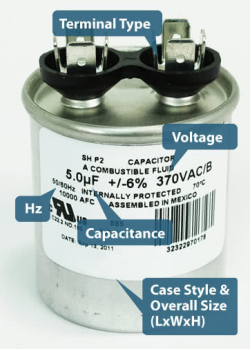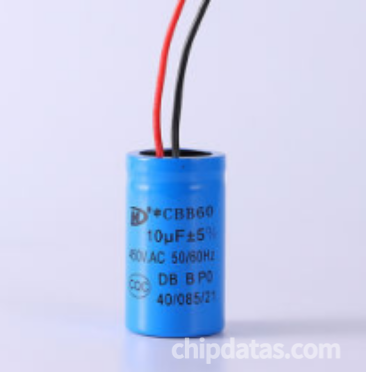Powerful Protection from Payment to Delivery
Secure and Reliable Payment
Money Back Guarantee
Shipping and Delivery
After-Sales Service
Enter the order reference number received by email to check the status or make payment.
The function and selection method of running capacitor
1. Introduction
Motor capacitors play a crucial role in enhancing the performance and efficiency of motors by temporarily storing electrical charge. Specifically, start capacitors offer additional torque during motor startup and are subsequently removed from the circuit once the motor reaches its operating speed. On the other hand, run capacitors assist the motor in maintaining a consistent charge while it is running. Additionally, power factor correction capacitors help balance working power and supplied power, thereby reducing motor power consumption resulting from heavy inductive loads. While motor capacitors are commonly utilized in HVAC applications such as fans, blowers, and compressors, they are also present in pumps, conveyors, and machine tools.
2. Two Types of Motor Capacitor
There are two main types of motor capacitors: run capacitors and starter capacitors. Let's take a closer look at each of them Capacitors.
2.1 Run Capacitors
Run capacitors are typically rated in the range of 3 to 70 microfarads (uF). They are also classified based on voltage levels, which are commonly 370V and 440V. Unlike starter capacitors, run capacitors are designed for continuous duty and remain energized throughout the motor's operation. Their primary function is to provide additional torque and stabilize the motor's charge.
The sizing of run capacitors is crucial because they are responsible for powering a second phase winding in single-phase electric motors. If an incorrect run capacitor is installed, the motor will not have an even magnetic field. This can cause the rotor to hesitate at uneven spots, resulting in noise, increased energy consumption, reduced performance, and motor overheating.
2.2 Starter Capacitors
Starter capacitors, on the other hand, have a different configuration compared to run capacitors. They are housed in black plastic cases and have a range of microfarad ratings. Typically, starter capacitors have ratings of 70 microfarads or higher and are classified into three voltage classes: 125V, 250V, and 330V. For example, a 35uF capacitor at 370V is a run capacitor, while an 88-108uF capacitor at 250V is a start capacitor.
The main purpose of starter capacitors is to increase the starting torque of the motor and enable rapid cycling of the motor on and off. Unlike run capacitors, starter capacitors are designed for one-time use only. They are energized for a short period, allowing the motor to reach approximately 3/4 of its full speed before being disconnected from the circuit.
3. Specifications of Run Capacitor
Most run capacitor applications typically use capacitance ratings ranging from 2.5 to 100 microfarads (uf) and voltages of 370 or 440 volts AC. These capacitors are designed to operate at frequencies of 50 or 60 Hz. They are usually housed in round or oval-shaped cases made of steel or aluminum, with a shell and cap. The terminals are typically 14“ push-on terminals, with 2 to 4 terminals per connection post.
Here are some important considerations when selecting a run capacitor:
3.1 Voltage: It is important to choose a capacitor with a voltage rating that is equal to or higher than the original capacitor. If the original capacitor is rated at 370 volts, you can use either a 370-volt or a 440-volt capacitor. However, the 440-volt capacitor will generally have a longer lifespan. The voltage rating on a run capacitor indicates the acceptable peak voltage, not the operational voltage.
3.2 Capacitance: It is generally recommended to choose a capacitor with the same capacitance value (measured in microfarads, MFD, or uf) as the original capacitor. The capacitance value determines the motor's operational characteristics, so it is important not to deviate too much from the original value.
3.3 Frequency (Hz): A run capacitor marked as 50/60 Hz is the best choice, as it matches the frequency of the original capacitor.
3.4 Case Style: The case style, whether oval or round, does not have any electrical significance. The choice between oval and round capacitors is mainly based on the available space for installation. Round run capacitors are more commonly used, but oval designs are still used in many motors.
3.5 Overall Size: The overall size of the capacitor is also not electrically significant. It is important to choose a capacitor that will fit in the available space in the mounting box.
3.6 Terminal Type: Most run capacitors have 1 to 4 14" push-on tabs with 3 or 4 tabs per connection post. It is important to ensure that the capacitor has enough tabs to make the necessary connections.

4. Faulty Run Capacitor
4.1 When is it necessary to replace the run capacitor?
Generally, the capacitance of the run capacitor is much larger than that of the start capacitor. The run capacitor may experience varying degrees of wear, making it more complicated to determine when it needs to be replaced.
When the run capacitor starts operating outside of its allowed range, the rated capacitance typically decreases. For most standard motor run capacitors, there is a specified "tolerance" that describes the closeness of the actual value to the rated capacitance. This tolerance is usually between +/- 5% to 10%. For most motors, as long as the actual value is within 10% of the rated value, it can still function properly.
Occasionally, the run capacitor may expand due to internal pressure, either due to defects in the internal structure of the capacitor or motor issues unrelated to the capacitor. Most modern run capacitors are designed to open the circuit and disconnect the internal spiral film to prevent the capacitor from bursting.
Testing is simple: when the capacitor expands and there is no continuity between the terminals, it is time to replace the capacitor.
4.2 Causes of failure
Depending on how close the run capacitor is to its designed lifespan, there can be several reasons for its failure.
- Time - All capacitors are designed with a certain lifespan. The lifespan of the run capacitor can be controlled by factors such as replacement or combination, but once the designed lifespan is exceeded, the internal decay may accelerate, leading to poorer performance. In simple terms, the capacitor may fail due to "aging."
- Temperature - Operating at temperatures higher than the design limit significantly affects the lifespan of the run capacitor. In general, the lifespan of run capacitors in motors operating in hot environments or with poor ventilation is significantly reduced. Motors that operate at higher temperatures radiate heat to the capacitor, causing it to overheat. In well-cooled conditions, the run capacitor will have a longer lifespan.
- Current - When a motor experiences a fault, the capacitor may be overloaded. This situation is not common, as it usually accompanies partial or complete motor failure. Motor overload or winding faults can cause an increase in current, which may affect the capacitor.
- Voltage - This factor has an exponential impact on the designed lifespan. Run capacitors have a voltage rating that should be limited. For example, using a capacitor with a voltage rating of 440VAC at 450VAC may decrease its lifespan by 20%. At 460VAC, the lifespan may be halved. At 470VAC, the lifespan decreases by 75%, and so on. The same principle applies to reverse operation, where using a capacitor with a voltage rating significantly higher than required can extend its lifespan, although the impact is smaller.

5. How To Replace a Start Run Capacitor?
When installing a new motor, it is important to also replace the fan capacitor. To ensure proper reconnection, it is recommended to take photographs or make notes of the wire coloring and connections.
Here are the steps to replace the fan capacitor:
5.1 Turn off the power to the HVAC unit and use a meter to verify that it is completely off.
5.2 Locate and remove the side panel where the electricity is fed into the unit.
5.3 Identify the Stat Run Capacitor. In a Dual Run capacitor setup, there will only be one capacitor for the fan motor. If there are two capacitors, only the fan motor capacitor needs to be replaced.
5.4 Check the microfarad (MFD) rating and voltages of the old capacitor. Make sure to select a new capacitor with the same MFD rating and suitable voltage.
5.5 Connect the new capacitor one leg at a time, following the same connections as the old capacitor. This step ensures that the connections are correct. If there are two capacitors, one for the compressor and the other for the fan motor, make sure to connect the wires to the appropriate capacitor.
6. How Do They Work In an HVAC System?
A Start or Run Capacitor can be combined into a single capacitor with three leads known as a Dual Capacitor, or it can be split between two separate capacitors.
The Start Capacitor is responsible for providing the initial torque needed to start the fan motor spinning. Once the motor starts, the Start Capacitor turns off. On the other hand, the Run Capacitor remains active and provides additional torque to the motor when required.
If the Start Capacitor fails, it is highly likely that the motor will not start. On the other hand, if the Run Capacitor fails, the motor will still start, but the running amperage will be higher than normal. This can cause the motor to run hot and have a shorter lifespan.
A Dual Capacitor typically has three connections: HERM, FAN, and COM.
The HERM connection is intended for the Hermetically Sealed Compressor, the FAN connection is for the Condenser Fan Motor, and the COM connection is for the Contactor, which powers the Capacitor.
If the unit has two capacitors, the larger one is usually the Run Capacitor. It is important to note that the compressor often requires a HERM capacitor for its operation.
7. FAQ
1. What happens when a run capacitor goes bad?
When a run capacitor goes bad, it can cause various issues with the motor. It may lead to starting problems or even result in the motor shutting off while running. Similarly, a dirty coil can have a similar effect. If a run capacitor is faulty, the motor may still turn on, but the running amperage will be higher than normal. This can cause the motor to run hot and have a shorter life expectancy.
2. What is the difference between a capacitor and a run capacitor?
There is a difference between a capacitor and a run capacitor. The start capacitor is responsible for creating a current to voltage lag in the separate start windings of the motor. This slow buildup of current allows the armature to begin rotating with the field of current. On the other hand, a run capacitor utilizes the charge in the dielectric to boost the current, providing power to the motor.
3. Can I run my AC without a capacitor?
In most cases, the motors in your air conditioner cannot run without a functioning capacitor. The capacitor plays a crucial role in supporting these motors by helping them start and run efficiently. If the capacitor is faulty or missing, you may notice that the fan is not spinning on your AC as it should be.
4. Can I use a run capacitor in place of a start capacitor?
No, a run capacitor cannot be used as a start capacitor. The capacitance and voltage ratings of the capacitor would need to match the original start capacitor specifications. Additionally, a start capacitor is not designed to handle current continuously, so it cannot be used as a run capacitor.
5. Do I need a start or run capacitor?
Run capacitors are designed for continuous duty and remain energized throughout the motor's operation. Single-phase electric motors require a capacitor to energize a second phase winding. Start capacitors, on the other hand, are used to increase motor starting torque and allow for rapid cycling of the motor.
6. What size run capacitor do I need?
The run capacitor should have the exact microfarad (uf) rating that matches the motor's specifications. Capacitors with ratings above 70uf are typically start capacitors and are generally removed from the circuit during operation. The rule of +/- 10% of the rating is commonly followed for start capacitors only.
Recent Posts








Company
About UsContact UsTerms & ConditionsPrivacy StatementPayment,Shipping & InvoiceRefund & Return PolicyWarranty PolicyFrequently asked questionHolidays for Chinese Mid-Autumn Festival and National Day in 2023


















